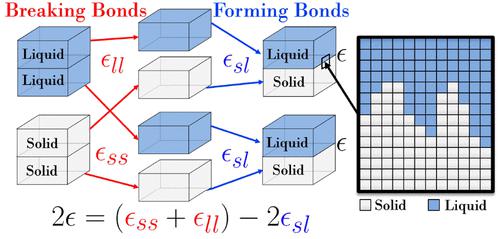Our official English website, www.x-mol.net, welcomes your feedback! (Note: you will need to create a separate account there.)
Model for the Solid–Liquid Interfacial Free Energy at High Pressures
Langmuir ( IF 3.9 ) Pub Date : 2022-08-03 , DOI: 10.1021/acs.langmuir.2c01097 Dane M Sterbentz 1, 2 , Philip C Myint 1 , Jean-Pierre Delplanque 2 , Yue Hao 1 , Justin L Brown 3 , Brian S Stoltzfus 3 , Jonathan L Belof 1
Langmuir ( IF 3.9 ) Pub Date : 2022-08-03 , DOI: 10.1021/acs.langmuir.2c01097 Dane M Sterbentz 1, 2 , Philip C Myint 1 , Jean-Pierre Delplanque 2 , Yue Hao 1 , Justin L Brown 3 , Brian S Stoltzfus 3 , Jonathan L Belof 1
Affiliation

|
The free energy involved in the formation of an interface between two phases (e.g., a solid–liquid interface) is referred to as the interfacial free energy. For the case of solidification, the interfacial free energy dictates the height of the energy barrier required to nucleate stable clusters of the newly forming solid phase and is essential for producing an accurate solidification kinetics model using classical nucleation theory (CNT)-based methods. While various methods have been proposed for modeling the interfacial free energy for solid–liquid interfaces in prior literature, many of these formulations involve making restrictive assumptions or approximations, such as the system being at or near equilibrium (i.e., the system temperature is approximately equal to the melt temperature) or that the system is at pressures close to atmospheric. However, these approximations and assumptions may break down in highly non-equilibrium situations, such as in dynamic-compression experiments where metastable liquids that are undercooled by hundreds of kelvin or overpressurized by several gigapascals or more are formed before eventually solidifying. We derive a solid–liquid interfacial free-energy model for such high-pressure conditions by considering the enthalpies of interactions between pairs of atoms or molecules. We also consider the contribution of interface roughness (disordering) by incorporating a multilayer interface model known as the Temkin n-layer model. Our formulation is applicable to a diverse variety of materials, and we demonstrate it by developing models specifically for two different materials: water and gallium. We apply our interfacial free-energy formulation to CNT-based kinetics simulations of several suites of dynamic-compression experiments that cause liquid water to solidify to the high-pressure solid polymorph ice VII and have found good agreement to the observed kinetics with only minor empirical fitting.
中文翻译:

高压下固液界面自由能模型
参与形成两相之间的界面(例如,固-液界面)的自由能称为界面自由能。对于凝固的情况,界面自由能决定了使新形成的固相稳定团簇成核所需的能垒高度,并且对于使用基于经典成核理论 (CNT) 的方法生成准确的凝固动力学模型至关重要。虽然在先前的文献中已经提出了各种方法来模拟固-液界面的界面自由能,但这些公式中的许多都涉及做出限制性假设或近似,例如系统处于或接近平衡状态(即系统温度大致相等到熔体温度)或系统处于接近大气压的压力下。然而,这些近似和假设在高度非平衡的情况下可能会失效,例如在动态压缩实验中,在最终凝固之前形成过冷数百开尔文或过压数千兆帕斯卡或更多的亚稳态液体。我们通过考虑原子或分子对之间相互作用的焓,推导出这种高压条件下的固-液界面自由能模型。我们还通过合并称为 Temkin 的多层界面模型来考虑界面粗糙度(无序)的贡献 例如在动态压缩实验中,在最终凝固之前形成过冷数百开尔文或过压数千兆帕斯卡或更多的亚稳态液体。我们通过考虑原子或分子对之间相互作用的焓,推导出这种高压条件下的固-液界面自由能模型。我们还通过合并称为 Temkin 的多层界面模型来考虑界面粗糙度(无序)的贡献 例如在动态压缩实验中,在最终凝固之前形成过冷数百开尔文或过压数千兆帕斯卡或更多的亚稳态液体。我们通过考虑原子或分子对之间相互作用的焓,推导出这种高压条件下的固-液界面自由能模型。我们还通过合并称为 Temkin 的多层界面模型来考虑界面粗糙度(无序)的贡献n层模型。我们的配方适用于多种材料,我们通过专门为两种不同材料开发模型来证明这一点:水和镓。我们将我们的界面自由能公式应用于几组动态压缩实验的基于 CNT 的动力学模拟,这些实验导致液态水凝固成高压固体多晶型冰 VII,并且发现与观察到的动力学有很好的一致性,只有少量的经验配件。
更新日期:2022-08-03
中文翻译:

高压下固液界面自由能模型
参与形成两相之间的界面(例如,固-液界面)的自由能称为界面自由能。对于凝固的情况,界面自由能决定了使新形成的固相稳定团簇成核所需的能垒高度,并且对于使用基于经典成核理论 (CNT) 的方法生成准确的凝固动力学模型至关重要。虽然在先前的文献中已经提出了各种方法来模拟固-液界面的界面自由能,但这些公式中的许多都涉及做出限制性假设或近似,例如系统处于或接近平衡状态(即系统温度大致相等到熔体温度)或系统处于接近大气压的压力下。然而,这些近似和假设在高度非平衡的情况下可能会失效,例如在动态压缩实验中,在最终凝固之前形成过冷数百开尔文或过压数千兆帕斯卡或更多的亚稳态液体。我们通过考虑原子或分子对之间相互作用的焓,推导出这种高压条件下的固-液界面自由能模型。我们还通过合并称为 Temkin 的多层界面模型来考虑界面粗糙度(无序)的贡献 例如在动态压缩实验中,在最终凝固之前形成过冷数百开尔文或过压数千兆帕斯卡或更多的亚稳态液体。我们通过考虑原子或分子对之间相互作用的焓,推导出这种高压条件下的固-液界面自由能模型。我们还通过合并称为 Temkin 的多层界面模型来考虑界面粗糙度(无序)的贡献 例如在动态压缩实验中,在最终凝固之前形成过冷数百开尔文或过压数千兆帕斯卡或更多的亚稳态液体。我们通过考虑原子或分子对之间相互作用的焓,推导出这种高压条件下的固-液界面自由能模型。我们还通过合并称为 Temkin 的多层界面模型来考虑界面粗糙度(无序)的贡献n层模型。我们的配方适用于多种材料,我们通过专门为两种不同材料开发模型来证明这一点:水和镓。我们将我们的界面自由能公式应用于几组动态压缩实验的基于 CNT 的动力学模拟,这些实验导致液态水凝固成高压固体多晶型冰 VII,并且发现与观察到的动力学有很好的一致性,只有少量的经验配件。



























 京公网安备 11010802027423号
京公网安备 11010802027423号